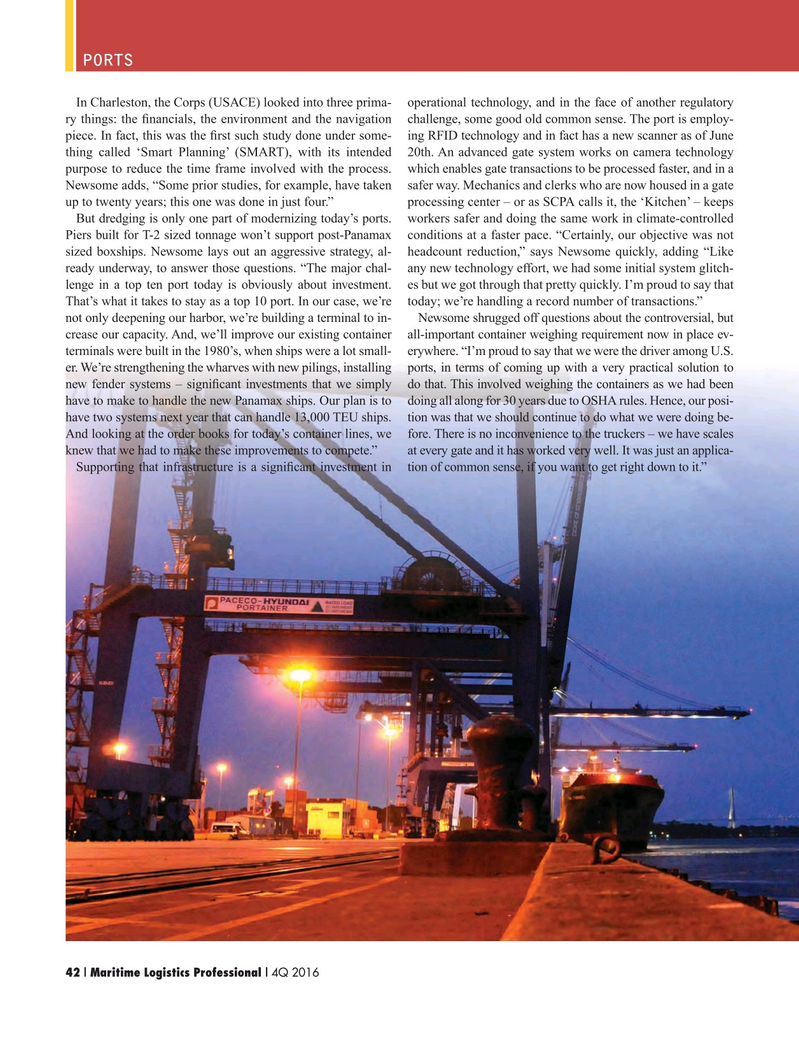
Page 42: of Maritime Logistics Professional Magazine (Q4 2016)
Workboats
Read this page in Pdf, Flash or Html5 edition of Q4 2016 Maritime Logistics Professional Magazine
PORTS
In Charleston, the Corps (USACE) looked into three prima- operational technology, and in the face of another regulatory ry things: the ? nancials, the environment and the navigation challenge, some good old common sense. The port is employ- piece. In fact, this was the ? rst such study done under some- ing RFID technology and in fact has a new scanner as of June thing called ‘Smart Planning’ (SMART), with its intended 20th. An advanced gate system works on camera technology purpose to reduce the time frame involved with the process. which enables gate transactions to be processed faster, and in a
Newsome adds, “Some prior studies, for example, have taken safer way. Mechanics and clerks who are now housed in a gate up to twenty years; this one was done in just four.” processing center – or as SCPA calls it, the ‘Kitchen’ – keeps
But dredging is only one part of modernizing today’s ports. workers safer and doing the same work in climate-controlled
Piers built for T-2 sized tonnage won’t support post-Panamax conditions at a faster pace. “Certainly, our objective was not sized boxships. Newsome lays out an aggressive strategy, al- headcount reduction,” says Newsome quickly, adding “Like ready underway, to answer those questions. “The major chal- any new technology effort, we had some initial system glitch- lenge in a top ten port today is obviously about investment. es but we got through that pretty quickly. I’m proud to say that
That’s what it takes to stay as a top 10 port. In our case, we’re today; we’re handling a record number of transactions.” not only deepening our harbor, we’re building a terminal to in- Newsome shrugged off questions about the controversial, but crease our capacity. And, we’ll improve our existing container all-important container weighing requirement now in place ev- terminals were built in the 1980’s, when ships were a lot small- erywhere. “I’m proud to say that we were the driver among U.S. er. We’re strengthening the wharves with new pilings, installing ports, in terms of coming up with a very practical solution to new fender systems – signi? cant investments that we simply do that. This involved weighing the containers as we had been have to make to handle the new Panamax ships. Our plan is to doing all along for 30 years due to OSHA rules. Hence, our posi- have two systems next year that can handle 13,000 TEU ships. tion was that we should continue to do what we were doing be-
And looking at the order books for today’s container lines, we fore. There is no inconvenience to the truckers – we have scales knew that we had to make these improvements to compete.” at every gate and it has worked very well. It was just an applica-
Supporting that infrastructure is a signi? cant investment in tion of common sense, if you want to get right down to it.” 42 | Maritime Logistics Professional | 4Q 2016 34-49 Q4 MP2016.indd 42 11/9/2016 12:25:44 PM

 41
41

 43
43
